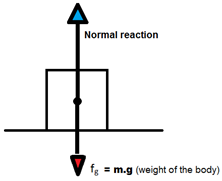Types of Forces
Table of Content |
If we want to produce motion in a body, already at rest, or if we want to destroy the motion of a moving body, we have to apply ‘effort’ known as force in the form of a pull or push.
Force:-

Force is defined as that pull or push which produces or tends to produce, destroys or tends to destroy motion in a body, increases or decreases the speed of the body or changes its direction ofmotion. Therefore, “Force" is an external or internal agent present to "influence" the natural state of motion of an object. Thus, this is an influence (force) needed to change the natural state of body; that is of rest or of uniform motion.
Force is the basic cause of motion.
Classification of Forces:-
There are different types of forces in our universe. Based on the nature of the interaction between two bodies, forces can be classified into two main categories.
(a) Contact Forces:-
These are the forces which come into play due to actual contact between the sources and the object. Basically, it is the force that act between the bodies in contact with each other. For example, Normal Reaction, Friction etc.
(i) Tensional Force (T):-
When a string, thread or wire is held taut, the ends of the string or thread (or wire) pull on whatever bodies are attached to them in the direction of the string. This force is known as Tension.
If the string is massless, then the tension T has the same magnitude at all points throughout the string.
The direction of tension is always from the point of attachment to the body.

(ii) Spring Force:-
Force in an extended (or compressed) spring is proportional to the magnitude of extension (or compression).
i.e. F α x, in magnitude, but opposite in direction.
So, F = -kx, where k is a positive constant, also known as the spring constant of the spring; and x is the compression or elongation from the natural length.
(iii) Normal reaction:-

When a body exerts a force on another, the second provides a reaction which acts perpendicular to the surface of 2nd body.
(iv) Friction:-
It is a force that acts between bodies in contact with each other along the surface of contact and it opposes relative motion (or tendency of relative motion) between the two bodies.

(v) Air Resistance (Fa):-
Applicable when motion takes place through air. This force becomes appreciable for bodies moving at high speeds.

(vi) Weight (W):-
It is a field force, the force with which a body is pulled towards the center of the earth due to its gravity. It has the magnitude mg, where m is the mass of the body and g is the acceleration due to gravity.

(b) Non-Contact Forces (Field Forces or Action at a Distance Forces):-
Forces which come into existence without any physical contact between the bodies. These forces are due to some inherent characteristics of the body.
Forces that act between bodies separated by a distance without any actual contact. For example, Tension, Spring, Weight etc.
Examples:-
(i) Gravitational Forces (Fg):- This is due to the gravitation attraction between two bodies. If we deal with cases of attraction due to earth, this force is always directed downwards.
(ii) Electrical Forces (Felec):- These forces are due to the charges present on the two bodies. The direction of these forces depends upon the type of charges on the two interacting bodies.
(iii) Magnetic Forces (Fmag):- Forces which come into play between two bodies due to their magnetic characteristics. Their direction also depends upon the nature of magnetic polarity acquired by the body.
In mechanics we shall only deal with gravitational forces from this category.
Related Resources:-
-
Click here for the Detailed Syllabus of IIT JEE Physics.
-
Look into the Sample Papers of Previous Years to get a hint of the kinds of questions asked in the exam.
-
You can get the knowledge of Useful Books of Physics.
To read more, Buy study material of Laws of Motion comprising study notes, revision notes, video lectures, previous year solved questions etc. Also browse for more study materials on Physics here.
View courses by askIITians


Design classes One-on-One in your own way with Top IITians/Medical Professionals
Click Here Know More

Complete Self Study Package designed by Industry Leading Experts
Click Here Know More

Live 1-1 coding classes to unleash the Creator in your Child
Click Here Know More
